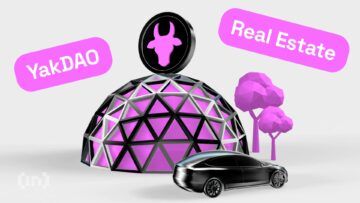Have you ever wondered how to reduce Ethereum gas fees? You’re not the only one, as many teams are working on solutions. One of these is Arbitrum, a Layer 2 scaling solution that is growing in usage. But what is a Layer 2 solution, and what exactly is Arbitrum?
In this article, we’ll go over one of the most popular Layer 2 scaling solutions for Ethereum. Let’s find out what Arbitrum is and how you can start using it right now.
In this guide:
What are Layer 2 solutions on Ethereum?

Layer 2 solutions have been created on top of the Ethereum blockchain to help reduce network congestions and transaction gas fees.
In its present form, it’s a known fact that scalability is an issue for the Ethereum blockchain. On Layer 1, the scalability issue can be improved by increasing the number of transactions that can be verified at once. However, given the network’s current state, that would require that the network’s security, decentralization, or both, be compromised.
ETH2 seeks to make important Layer 1 security changes, but this will take some time, and the network requires immediate solutions. Luckily, the mainnet is expected to be launched by the end of 2022. ETH2 is considered an upgrade and will effectively transform the network into a Proof-of-Stake (PoS) platform.
In the short term, however, solutions such as Optimistic Rollups or zero-knowledge (ZK) Rollups can be used to scale Layer 2. One such example of an Ethereum Layer 2 solution is Arbitrum, an L2 expansion rollup called Optimistic Rollup.
Optimistic Rollups assume that all new additions to a chain are valid unless challenged by a participant within about one week. ZK-rollups use cryptographic proofs as a means to verify every block that is added to the network. This eliminates the need to trust validators. ZK-rollup technology may be the most advanced Layer 2 technology, but it is still more complicated than Optimistic Rollups. It needs further development.
Rollups are one of the most in-demand types of Layer 2 solutions. These smart contracts validate large numbers of transactions off-chain, sending a minimal amount of data back onto the main network. The goal is to prevent computation and state storage (a data tree of all transactions made on the blockchain) from clogging the main network.
What is Arbitrum?

Arbitrum is a Layer 2 solution that enhances the capabilities of Ethereum’s smart contracts. It helps increase transaction speed and the overall scalability, while also adding extra privacy features. If, let’s say, you want to use any of the decentralized exchanges (DEXs) on Ethereum, then you would have to pay the current level of the Ethereum gas fees. It is notoriously high, and it might decrease parts of your portfolio and profits. To reduce these fees, an investor could use the Arbitrum network to access those same DEXs and the same ETH tokens while paying much lower fees for the transactions.
This platform allows developers to run unmodified Ethereum Virtual Machine (EVM), contracts, and Ethereum transactions on a secondary layer while still enjoying the security of Ethereum’s Layer 1.
Arbitrum was built to fix some of the weaknesses of Ethereum-based smart contract technology. These include low efficiency and high execution costs, which can lead to a poor user experience. Most importantly, Arbitrum helps Ethereum users to avoid the high gas fees of the network.
Arbitrum uses Optimistic Rollups to record transactions submitted on Ethereum’s main chain and then execute them on a Layer 2 sidechain. This allows for accurate results while also leveraging Ethereum. By using Arbitrum, Ethereum reduces its storage and computational burdens. Many Ethereum DApps are also available on Layer 2 solutions, including Arbitrum.
Arbitrum is developed by Offchain Labs, a New York-based development company. Offchain Labs founders, Ed Felten and Steven Goldfeder, along with Harry Kalodner, are leading the initiative, as they are all deeply passionate about blockchain and cryptocurrencies. Ed Felten is a computer science professor at Princeton. Steven earned his PhD, while Harry is currently a Princeton University PhD student.
How does Arbitrum work?
Arbitrum is processing Ethereum transactions through an Optimistic Rollup protocol. The Ethereum smart contracts can be scaled up by using this Layer 2 solution, which is built on top of it. The second layer handles most of the transaction processing and reports back to Ethereum. These results are then recorded on the main blockchain, greatly increasing speed and efficiency.
Like many blockchains, Arbitrum can be joined by individual nodes. Full nodes are used to assist in accumulating Layer 1 transactions, and validator nodes are used to monitor the chain’s state. The rewards for aggregators who submit transactions to the Layer 1 chain are paid in ETH. All other network participants receive the remainder of the user transaction fees, such as validators.
Arbitrum introduces a challenging stage for rollup blocks. This allows other validators to check the accuracy of a block and challenge it if they think it is incorrect. The stake of the lying validator can be confiscated if the block is found to be invalid or the challenge is not justified. This ensures that validators play fair and do not risk the consequences.
The network also features its own virtual machine, the Arbitrum Virtual Machine (AVM), which exists on top of EthBridge to execute the Arbitrum smart contracts. The AVM automatically converts Ethereum-compatible smart contracts to run on it.
Let’s see how exactly the Optimistic Rollup works.
What is an Optimistic Rollup?
An Optimistic Rollup process implies that transaction execution is an off-chain process. Rollups use their own infrastructure for transactions. A rollups protocol can be described as decongestants for the Ethereum network.
Rollups relieve Ethereum by supporting Ethereum-based activities which would otherwise have to be executed on the already cluttered Layer 1, which is the Ethereum network. What’s special about these rollup protocols is the way they handle data.
Rollups can execute transactions off-chain and have the capacity to transmit data to Ethereum’s mainnet. The Optimistic Rollup relies on fraud proofs, which assume that the posted data is valid unless it is challenged.
The Optimistic Rollup means that any validator can post rollup blocks and confirm the validity of other blocks. The term rollup describes how public information can help reconstruct the complete chain history from an optimized log.
Arbitrum’s Optimistic Rollups can be settled using a proprietary sidechain. Sidechains are blockchains that are connected to a mainchain, in this case, Ethereum. Arbitrum gathers transactions in batches, settles them on its sidechain, and then feeds the transaction data back into the Ethereum blockchain ledger. Arbitrum’s protocol ensures that code runs correctly, as long as the validator is honest. This helps to resist collusion and other attacks.
Arbitrum states that transactions confirmed by this process will be rubber-stamped with the “AnyTrust guarantee” — when all validators agree to the validity of transactions within a block. Validators must stake ETH before they can confirm transactions. By staking crypto, they are incentivized and encouraged to act honestly.
What is the Arbitrum Bridge?
The Arbitrum One Bridge allows anyone to send ERC-20 tokens, including ETH, to Arbitrum One, a Layer 2 scaling solution for Ethereum. To use it, you must connect your Ethereum wallet to the bridge. You can use MetaMask or any of the supported wallets.
Numerous top decentralized finance (DeFi) platforms, such as Aave, Balancer, 1inch, Band Protocol, and Curve, are already leveraging Arbitrum or looking to do so to increase throughput and lower their fees. You can check out its portal to see all the Ethereum DApps available on the Arbitrum Layer 2.
Arbitrum features
Arbitrum Rollup presents some great features, including:
- Optimistic outcomes: Arbitrum’s rollup process can be described as “optimistic.” This means that transactions processed through Arbitrum will be valid and true at the time of transaction. Arbitrum validators can post rollup blocks and verify the validity of others. The network will work as intended as long as there is at least one honest validator for each transaction batch.
- Effective data compression: Arbitrum treats multiple Ethereum smart contracts as one object when bridging onto its chain. This can help simplify the rollup process. Once these transactions have been processed, the only data that is sent back to Ethereum mainnet are the transactions’ “calldata.” This contains the hashes for the confirmed rollup blocks and not the actual blocks. Because calldata is smaller than the transactions it derives from, they can be processed easily by the Ethereum mainnet.
- Validator subsets. These are available to developers who choose to run their DApps using Arbitrum. They can select their own validators to carry out their consensus work. A validator can’t be involved in any other DApp that runs on Arbitrum. This is unlike validators on Ethereum mainnet, who are responsible for validating all transactions on the network. Arbitrum’s localized validation configuration means that less communication is required between nodes. This results in faster processing speeds and helps to resist collusion and other cyberattacks.
Arbitrum’s Optimistic Rollups may provide many benefits for the Ethereum network. However, there are some legitimate criticisms. Arbitrum has a delay between the time transactions are processed and their finality. It allows transactions to be challenged within one week. In disputes, transactions in suspicious bundles can be left in limbo for up to a week before being verified and released.
Arbitrum risks and challenges
Like any other blockchain that supports smart contracts, Arbitrum is also exposed to smart contract risk and vulnerabilities. Users can lose funds if there is an issue with the smart contracts that operate this platform.
To allow verifiers sufficient time to detect fraud on the Arbitrum network, the standard withdrawal process takes around seven days. Although it takes much longer than users want to wait, this is a necessary reality for young Optimistic Rollups. However, third-party services may offer faster withdrawals for a fee. Cross-chain systems like Hop Protocol will probably become more popular among users who don’t want to wait that long.
Low liquidity in DApps has been another obstacle that early Arbitrum users have faced. This is understandable, given that Arbitrum One is a fairly new L2 solution.
How to use Arbitrum
To use Arbitrum, you can either access it through DApps like Aave or 1inch, or you can connect your wallet to the Arbitrum token bridge.
The main purpose of Arbitrum is to send ERC-20 tokens from the Ethereum mainnet to the Arbitrum network, to get rid of those ridiculously high gas fees.
To demonstrate how to use Arbitrum, we will connect a wallet to the bridge and use the applications available on the portal.
Step 1. Connect wallet to Arbitrum Bridge
Firstly, you’ll need to go to the Arbitrum Bridge and connect your wallet. The supported Ethereum wallets are MetaMask, WalletConnect, and Coinbase Wallet.
Step 2. Transfer ETH to Arbitrum L2
After connecting your Ethereum wallet, make sure you are on the Ethereum network in your wallet.
Select the ERC-20 token that you want to bridge over to Arbitrum and the amount. Click on Deposit when you are ready.
You will then get a notification from Arbitrum, stating that the transaction will take ten minutes and that you will not be able to withdraw your funds back to Ethereum for eight days.
You’ll then have to confirm the transaction from your wallet. However, note that the Ethereum gas fee is quite high, regardless of the transaction amount. Spending $30 to transfer $10 might not be the greatest solution. But each crypto investor should check the current Ethereum gas fees at the moment of the transaction.
Depending on your wallet, you should get a notification similar to this one:
Step 3. Add Arbitrum network to your wallet
Also, make sure that you add the Arbitrum network to your wallet. After you transfer your coins through the bridge, you won’t be able to see the funds in your wallet on the Ethereum network anymore. You will need to add the Arbitrum network. To do so, simply click on the Add L2 Network button in the top right.
If you want to add the Arbitrum network manually to your wallet, you need to go to your wallet
Click on the MetaMask extension and click on the Ethereum Mainnet network, at the top. Click on Add network and enter the following:
- Network Name: Arb1
- RPC: https://arb1.arbitrum.io/rpc
- Chain ID: 42161
- Currency Symbol: ETH
- Block Explorer URL: https://arbiscan.io
Your wallet will ask you if you want to add the Arbitrum network. Click on Approve.
You will also need to allow Arbitrum to switch your wallet’s network.
Step 4. Access Arbitrum’s DApps
You can browse through the Arbitrum One portal to discover all the Ethereum apps available in Layer 2. When you choose any of them, you will be taken to the DApp, where you can connect your wallet and select the Arbitrum network.
Let’s say we want to use 1inch.
When we go to the app and connect our wallet, we can switch to Arbitrum, and benefit from the lower fees offered by the network. Instead of performing all trades directly on the Ethereum blockchain, which would incur high fees for every single transaction, we use Arbitrum. You can perform the same trades, without paying the astronomical gas fees.
Arbitrum vs. Optimism: A detailed comparison
The Optimism team created the rollup technology. The Arbitrum developers used their open-source code to add some of their own features and launched the Arbitrum network. The main differences between the two Ethereum Layer 2 solutions, Arbitrum and Optimism, are:
- Fraud proof verification
- Optimism’s Ethereum dependency
- Token bridges
Fraud proof verification
The main difference between Optimism and Arbitrum is the use of single-round fraud proofs. Arbitrum uses multiple-round fraud proofs.
Optimism’s single-round fraud-proof (FP) relies on L1 to complete the entire L2 transaction. This ensures that the verification of the FP is immediate. This comes at a higher cost because Layer 1 execution costs more gas, and the L2 fee itself is limited by the L1 gas block.
Arbitrum, on the other hand, uses a more detailed approach to verifying FP. Arbitrum uses multi-round FP to focus on one point of transaction disagreement. This results in better network performance. Because L2 transactions cannot be fully executed on L1, the gas block limit for L1 is irrelevant.
Optimism’s Ethereum dependency
Both Optimism and Arbitrum are Optimistic Rollup protocols, as they rely on the majority of Ethereum validators to process transactions accurately. However, if Ethereum is given a major consensus overhaul, the re-executing L1 transaction would result in divergent final states. Optimism uses EVM, an Ethereum Virtual Machine. It’s a virtual sandbox containing consensus rules for network use in each Ethereum node responsible for executing smart contracts.
Arbitrum has its own AVM (Arbitrum Virtual Machine), so there are no such worries. This requires DApps from EVM that are translated into AVM. However, it is an automatic process, and Arbitrum is in complete control of the benefits.
Optimism can only be used with a Solidity compiler to generate the OVM bytecode. A bytecode, which is a compiled program that has been compiled from source code and runs in a virtual machine. Arbitrum, on the other hand, supports all EVM programming languages such as Vyper, Solidity, Flint, YUL+, and LLLL.
Bridging and tokens
Both Arbitrum and Optimism use bridges to interconnect with other blockchains and facilitate the flow of tokens. On the other hand, Optimism uses a universal, permissionless bridge that can be used for all tokens. Arbitrum does this when it is convenient.
Finally, both rollups do not have their own tokens. Optimism uses Wrapped Ethereum (WETH) instead. This is a stablecoin that’s pegged to ETH at a 1:1 ratio. It allows for cross-chain ERC-20 tokens. Arbitrum supports native ETH without the need for additional steps.
Is Arbitrum the best solution for spending less on ETH fees?
Now that you know what Arbitrum is, you can decide if this is the best Layer 2 solution for you and your Ethereum portfolio. And that is different for each crypto user.
Layer 1 networks such as Ethereum and Bitcoin value security and decentralization over scaling. Arbitrum aims to resolve this blockchain trilemma by implementing Optimistic Rollups, which satisfy all three elements.
The Ethereum community believes that zk-Rollup is the best long-term solution. Arbitrum, the most advanced L2 platform, will hopefully continue to absorb current technology trends to scale the platform further and encourage its expansion.
Frequently asked questions
What is Arbitrum used for?
What is Arbitrum?
Is Arbitrum good for Ethereum?
Is Arbitrum the same as Ethereum?
Is Arbitrum a coin?
Trusted
Disclaimer
In line with the Trust Project guidelines, the educational content on this website is offered in good faith and for general information purposes only. BeInCrypto prioritizes providing high-quality information, taking the time to research and create informative content for readers. While partners may reward the company with commissions for placements in articles, these commissions do not influence the unbiased, honest, and helpful content creation process. Any action taken by the reader based on this information is strictly at their own risk. Please note that our Terms and Conditions, Privacy Policy, and Disclaimers have been updated.




